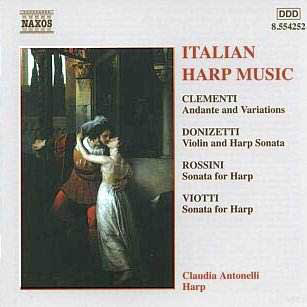I’ve always thought it strange that the harp isn’t
a more popular recital instrument. After all, many of its expressive
strengths and weaknesses are shared by the acoustic guitar, CDs of which
have always seemed to sell well. The harp’s softly percussive qualities
and intimate dynamic characteristics render a recital disc such as this
– comprising more than an hour of consistently quiet and agreeably melodic
music – a most satisfying and restful late-evening listening experience.
In its simplest form, the harp is an ancient instrument.
Even before its technical possibilities were dramatically extended (in
the early 19th century, by London-based maker Sébastien Erard)
there was a considerable repertory, albeit of lightweight music. Its
orchestral role developed from Beethoven (in Prometheus) through
Berlioz (most famously in the middle movement of Symphonie Fantastique)
until around 100 years ago, by which time few orchestral scores would
get far without two: think of La Mer, or the lovely cadenza in
the Ravel G major Piano Concerto, where resonant glissandi and harmonics
abound – but where there’s seldom any real melodic prominence.
This recital disc is made up of Italian music (in fact
Bochsa was French, but his piece is as much Bellini as Bochsa) written
in the early years of the life of the double-action semi-chromatic harp
(i.e. mostly around 1810-1830) but before the instrument acquired its
‘traditional’ orchestral idioms and associations. I say ‘semi-chromatic’
because, although the modern (in the sense of post-1810) harp is capable
of modulating (i.e. playing in different keys) it is not in its nature
to play meandering Tristanesque semi-tonal music: so there is
a level of technical sophistication (in terms of musical language) which
the harp isn’t able easily to reach. The CD programme we’re considering
here reflects that. It’s all easy-on-the-ear, unambitious, simply melodic
(though often florid and decorative) music, which demands little of
us as listeners, but a great deal of the player.
Not all of this music is actually written for harp:
the Clementi is a piano piece, and the Viotti appeared in various alternative
guises, and not solely for the harp. The Rossini pieces – as you might
guess from the running times – are disappointingly slight. The two Bellini-based
pieces work particularly well: they’re charming and catchy, and (far
more than anything else on the disc) technically challenging.
Claudia Antonelli won a number of international awards
as long ago as 1970: she’s also the dedicatee of numerous recent compositions,
mainly by contemporary Italians. (Perhaps, one day, Naxos could make
up a programme of such material to balance this one?) Like her violinist
colleague, she’s an able player: almost invariably on top of her task,
singing lines as well as a harp can – jumping the gap, so to speak,
from melodic note to melodic note, much as a guitarist must in order
to create the impression of a sustained line – and delivering
a range of dynamics and tone colours sufficient to maintain our attention
and sweeten the musical dish.
The notes are brief but adequate, telling us more about
the composers than the pieces themselves: and the recording is nicely
resonant, but controlled. A pleasant package, especially at the always-tempting
Naxos price.
Peter J Lawson


![]() See
what else is on offer
See
what else is on offer 